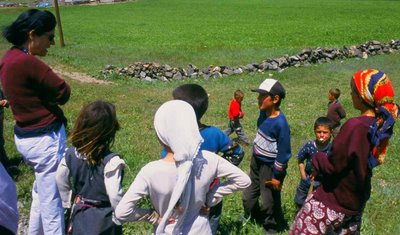
During fieldwork in
A short time later, during an interview in a neighboring village, I learned about beyaz toprak. Beyaz toprak is a regionally abundant white dust that is used for many purposes in the villages, including as a whitewash and a hardening agent in making a grape-based paste, pekmez. Unfortunately, beyaz toprak contains both asbestos and erionite. These chemicals have been shown to cause a rare and generally untreatable type of cancer, namely, malignant mesothelioma (Emri et al. 2002). Upon learning the nature of beyaz toprak, I immediately alerted the local medical staff to this fact, and was relieved to learn that they were aware of the situation, and had already taken initiatives to educate the villagers about the association between beyaz toprak and cancer.
This experience convinced me to the multifaceted nature of public health. Even in this relatively confined case, human health could be seen as a product of a complex nexus of cultural traditions, environmental variables, and biology. A better understanding of public health for the great diversity of humankind is even more challenging. Global public health is situated at the center of several seemingly unrelated processes, namely, shifts in biological and cultural adaptations of humans to their changing physical and cultural environments, as well as to the ever-evolving human pathogens; the increase in political and economic inequality; and the dramatic intensification of physical and cultural interactions between world populations.
Physical anthropology can and should play a leading role in studies of the public health. On one hand, the theoretical perspective of the field understands human health patterns under the umbrella framework of the adaptive mechanisms through which human cultural and biological diversity emerges. This perspective will allow physical anthropologists to explain processes in which the differences and similarities in public health patterns around the globe emerge. On the other hand, fieldwork experiences provide physical anthropologists with firsthand insights into local conditions, which subsequently allow inductive, and through cross-cultural comparisons, global perspectives on human health.
Specifically, physical anthropology explores the different mechanisms through which humans have adapted to different health challenges, such as disease (e.g., malaria), environmental stressors (e.g., high altitude adaptations), and socio-cultural differences (e.g., diet). These studies not only document regional cultural and biological diversity, but also address more deep-rooted questions about human evolution and adaptation. When contextualized within the evolutionary framework, the associations between human health and adaptation will be crucial to understand different medical histories of human groups, and consequently, to find new preventative measures and curative solutions to contemporary health problems, and, more importantly, to predict the future health challenges that our species faces.
Furthermore, in the wake of the “third epidemiological transition” (Barret et al. 1998), physical anthropology, through local readings of human health, can lead academia to a processual and temporal understanding of global public health. The need for a local perspective on disease processes and epidemiology to understand worldwide health issues has become even more important in the globalizing world. For example, the next avian flu pandemic may stem from one of the seemingly isolated cockfighting pits in
Many more examples of this kind can be cited, but the main point here is that cross-cultural physical anthropology studies provide a very powerful framework for understanding the patterns of human health. They allow not only a theoretically more complete perspective that integrates cultural traditions with biological patterns of health and disease, but also an inductive analysis of local trends in human health. The next wave of broader readings of human health and disease may come from none other than physical anthropologists.






No comments:
Post a Comment